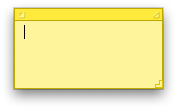Creating this overview is crucial in the understanding but making a sketch or drawing on a flip-chart it often limited:
- if something is drawn on paper it is difficult to rework later
- rearranging the components it often cumbersome because the whole board needs to shift or erased for rework
After some discussion we came up with: (similar to UML deployment diagrams)
 | Physical component:
|
 | Software component:
|
Please note that when discussing often the following is forgotten but should be included
- External dependencies that the application uses but the team does not manage (Mail Server, DNS Server, Internet Connection...)
- Identity all systems involved: including the systems needed for data replications, management (remote control), VPN for support, Backup
- If the applications are spread over sites , use some tape to group the components and label the locations
- Mark them as production or management
- Mark them as internally or externally managed
- If data is involved mark it (master, slave)
- Note special security precautions
- Capacity (# of users f.i. for webserver) or (# of CPU for hardware)
- Availabilty: check if failover/failback mechanism works if you take out one postit
- Data storage (local, SAN, ...)
- Check how it is monitored
- .... and of course many more
Our wall kept on growing after a few days, and new things came up and everybody learned. We brought in different groups so that they could complete the wall. Unfortuneatly I could not post the results here (confidential), but it would be nice to see how it worked for you.





